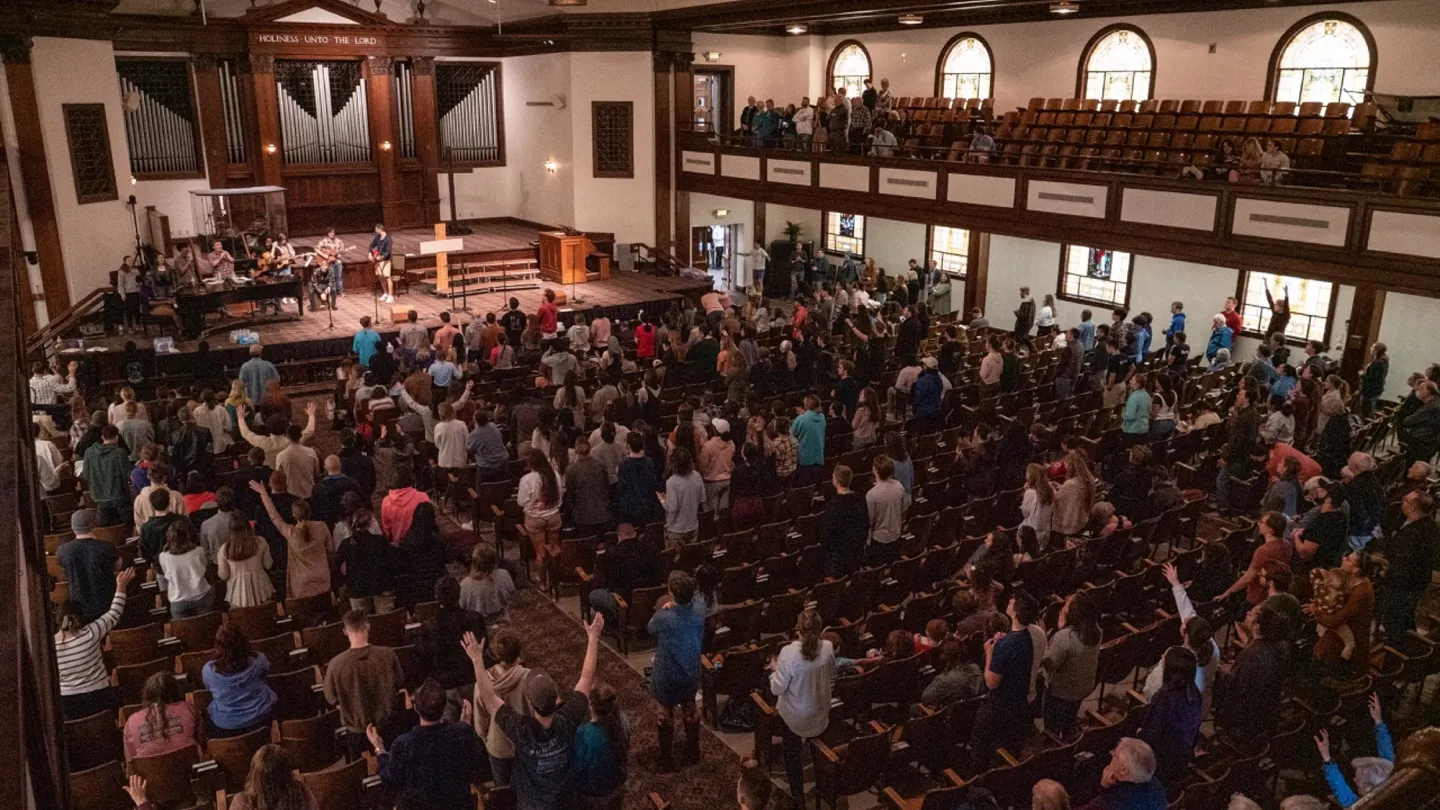Wind from Heaven: On the Asbury Revival

Asbury University’s Chapel, Wilmore, KY
The Asbury Revival
On Wednesday, February 8, students at Asbury University near Lexington, KY began worshipping in a normally scheduled chapel service. As the scheduled end for the service came, the worship kept going. And going. It didn’t take long for those present to realize that there was something different happening on campus. Unprompted by leaders or the chapel speaker, students continued to worship and respond, weeping, singing, confessing, and praying. Thousands of others students and visitors from around the country have come to join in. Saturday night, cars were backed up for miles outside of town, and over 20,000 people had come to campus to experience what God was doing there.
Dr. Kevin Brown is the president of Asbury University, and over the course of last week, he faced the difficult decision of how to respond to the revival happening on his campus. In a letter to the students, he wrote, “After much prayer and discussion with campus leadership, I am announcing our new schedule for the next week. This schedule is an attempt to recognize and steward this beautiful, historic moment of spiritual renewal while quickly moving toward a more sustainable campus experience for our students that fosters predictability, well-being, and continuity.”
The new schedule will slowly close down the revival and return the campus to normal. Starting today, the chapel will be open for services in the afternoon and evening, the first open to anyone and the second reserved for those under 25. The last service will occur on Thursday before they move to other locations. One factor Brown cited was the huge influx of outside visitors. Asbury chapel had become a focal point for the nation as thousands of visitors poured in each day. In the interest of safety and getting students back to class, he made the difficult decision to scale the services down and return the campus to its normal rhythms.
Of course, this decision will be met with opposition within Asbury and around the country. As a Christian school, you want your students to know and love God, serve him, encounter him, feel his call on their lives, and follow his will. Then you have a revival break out on your campus where students are repenting, worshipping, and dedicating themselves to the work of God and after a week and a half, you shut it down? Yes, there will be strong opposition along these lines.
I don’t envy Dr. Brown’s position, nor do I wish to second guess him. I’m not sure what I would do if I were in his shoes, but I do think we should all be paying attention to the revival and the aftermath. Similar services are now going on at dozens of college campuses. At churches across the country yesterday, pastors mentioned the revival and prayed for God’s continued work.
Some around the internet have expressed skepticism about the authenticity of what’s been going on. Is this really a work of God? Is this manufactured? How do we know this isn’t just a show or a fad? Will it be hijacked by outside groups and opportunists? It’s sad that in today’s world, so many of us react with cynicism, but too often, it has been justified. The more I see about what’s happened at Asbury, the more confident I am that this is a work of the Spirit we should be thankful for and that we should prayerfully support wherever we are. If this is anything like past revivals in America, it may lead to a resurgence of genuine faith among young people, hundreds of pastors and missionaries being called to ministry, and consequences we can’t even imagine (Eph. 3:20).
What Should We Make of Revivals?
What should we make of a “revival” breaking out? Depending on your background, this word can mean so many different things. Some churches plan revivals yearly, with services running in the evenings during the week or into the weekend. Others think of big events with thousands of people in a stadium, like the Billy Graham crusades of the 20th century. Of course, there is no formula for revival, but if you look at the history of what God has done, from the time of the Reformation in Europe, through the Puritans in England and Scotland, to the Great Awakenings in America, the Jesus Movement, and even the long history of revivals at Asbury University, there are some common characteristics we should consider.
This weekend, I had the opportunity to talk with some college students who had gone to Asbury to check things out. What they said surprised me. When they finally made it into the chapel (after waiting in line for hours), they said they were underwhelmed by what was going on. There was some worship music going on. A few people came up to the mic and gave words of encouragement or shared their testimonies. There was nothing earth-shattering, no one was preaching the paint off the walls, and there were no extraordinary manifestations of the spiritual gifts.
But they were completely overwhelmed by what was going on spiritually in the room. From the moment they entered, they could feel the presence of the Spirit in their hearts, convicting them of their sins and bringing them to a place of total surrender. They said the most powerful part of being there was listening to the dozens of students praying together and confessing their sins. The weight of those crying out over what they had done was audible in the room.
What they’ve described is an important factor in historical revivals. If you look throughout history, revivals are not brought on by awesome worship music, emotional movements, or even inspiring sermons. Revivals happen when people who have been going through the motions see the reality of their sin and the power of God’s forgiveness and grace. Often, the atmosphere is heavier than it is exciting, and the people affected are churched people, not those who would claim to be unbelievers. These other factors and experiences have been present, but they are often less significant than the repentance and surrender that takes place among the kind of people who would be attending chapel at Asbury University.
In his book, A Quest for Godliness, J.I. Packer describes the characteristics of revivals; “Revival I define as a work of God by his Spirit through his word bringing the spiritually dead to living faith in Christ and renewing the inner life of Christians who have grown slack and sleepy. In revival, God makes old things new, giving new power to law and gospel and new spiritual awareness to those whose hearts and consciences had been blind, hard and cold. Revival thus animates or reanimates churches and Christian groups to make a spiritual and moral impact on communities. It comprises an initial reviving, followed by a maintained state of revivedness for as long as the visitation lasts.”
In 1630, a group of Christians gathered for a Monday night service in Kirk of Shotts, Scotland. A young preacher, John Livingstone, preached for about an hour and a half on Ezekiel 36:25-26, “I will sprinkle clean water on you, and you shall be clean from all your uncleannesses, and from all your idols I will cleanse you. And I will give you a new heart, and a new spirit I will put within you. And I will remove the heart of stone from your flesh and give you a heart of flesh.” As the sermon grew to a close, a great rainstorm came up, and Livingstone continued preaching. After another hour of preaching, nearly 500 people repented and came to Christ.
In other cases, people have been praying for God to bring about revival long before it ever happens. I can vividly remember reading Dan Hayes’s book Fireseeds of Spiritual Awakening as he recounted the stories of spiritual awakening and the necessity of prayer leading up to them. He quotes G. Campbell Morgan to characterize the relationship between prayer and God’s sovereignty in bringing revival; “We cannot organize revival, but we can set our sails to catch the wind from heaven when God chooses to blow upon his people once again.”
Among so many other things, revivals often lead to an increase in missionaries and evangelists. I hope this revival leads to an army of young people who want to give their lives to the Great Commission, here and across the world. The modern missionary movement was launched in the late 18th century by a British shoemaker named William Carey, who had been attending monthly prayer meetings for revival. When revival finally came, so did the missionaries.
How Can We Pray?
The most important thing to remember, though, is that revival is totally and completely dependent on God. It is impossible for any person to bring it on, and it is impossible for any person to stop it. Revival is a work of God, to God, and through God by the Spirit. In Dr. Martyn Lloyd-Jones’s book Revival, he writes, “Revival, above everything else, is a glorification of the Lord Jesus Christ, the Son of God. It is the restoration of Him to the center of the life of the Church. You find this warm devotion, personal devotion, to Him.” This is what we should be praying for this week. As the Asbury revival services come to a close, we should ask that it would only be the beginning of God’s renewing work.
Dr. Cole Feix is the founder and president of So We Speak and the Senior Pastor of Carlton Landing Community Church in Oklahoma.




